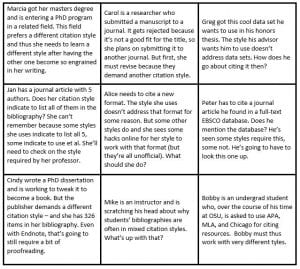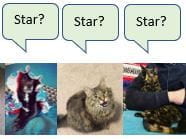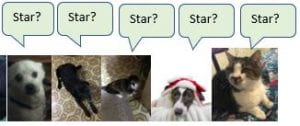Written by Craig Gibson, Professor and Professional Development Coordinator at The Ohio State University Libraries, Drake Institute Faculty Fellow for Mentoring
I recently asked a colleague and friend in the library field, who’s had much experience in observing and consulting on organizational change processes, what is meant by the phrase that we often hear, “organizational learning.” She replied, it’s when an organization decides collectively to pivot together toward new ways of operating based on new understandings achieved together, shifts in mindset accomplished together, and new agreements enabling that new way of being together. I found this explanation compelling both for its succinctness and its depth. Organizational development and the well-known “learning organization” model of Peter Senge have become commonplaces in the business and management literature, and are staples of strategic planning-speak, but we have not always understood well enough what in libraries, real organizational learning entails. This concept also needs to be distinguished from the “learning organization” idea, because the latter may for some suggest an endpoint, a static place or arrival, rather than the idea of continuous learning conveyed by “organizational learning.” We need to reflect on what continuous learning means and develop the mental and emotional stamina to engage in it.
Our own leadership institutes, workshops, and other professional development events in our field address this issue of organizational learning only in part. The Harvard Leadership Institute for Academic Librarians, for example, has drawn on the work of Kegan and Lahey in helping individual leaders understand their own “big assumptions” and “immunity to change” in advancing initiatives, and such frameworks are broadly congruent with the work of Heifetz in his well-known distinction been “adaptive learning” and “technical learning” in creating organizational change—that is, how organizations and those leading them must understand that adaptive change requires learning, working through ambiguous and messy processes, addressing values and complexities, rather than deciding quickly on what the “problem” is and devising a solution for it. Technical or more routine learning assumes clear-cut answers; adaptive learning assumes no easy answers and uses uncertainties and opportunities as opportunities for learning. With the Heifetz model, however, it is still the mindset of individual leaders in making this shift that matters. The role of the leader in making that shift is crucial, but the model needs further elaboration in developing collective leadership in order to enable organizational learning in a deeper way.
In reflecting on the organizational complexities of academic libraries in recent years, I have tapped into other thinkers to consider organizational learning in a broader way. We have too often become self-referential and inward-looking in reflecting on what organizational learning requires, and the leadership necessary to catalyze it, or have assumed that there is always a “fix”—a technical solution—for deep cultural barriers to change.
One of the foundational thinkers I’ve become familiar with in the field of organizational development is Henry Mintzberg of McGill University, well-known scholar, speaker, writer, and often contrarian on issues of strategic planning and organizational learning. While his investigations have most often occurred in corporations and nonprofits, they resonate for higher education and libraries as well. His views on the fallacies and weaknesses of traditionally rigid strategic planning are well-known. Less well-known is his view of leadership qualities and how organizational leaders enable, or fail to enable, organizational learning. Mintzberg asserts, based on his career of consulting in organizations, conducting research on their behavioral patterns, and getting a grounded view of organizational realities, that organizational learning develops only through building communities within them, not through imposing hierarchical structures. He saw emergent strategies—those developed through improvisation and reacting to events and responding creatively, such as the IKEA corporation did with its disassembled furniture—as just as important, if not more so, than carefully detailed and crafted strategic plans, because in the emergent world of creative responses and reimaginings, collective learning happens. He coined a new term, “communityship”, to replace the too-often used “leadership”, to convey the idea that creating communities within organizations, and fostering learning through them, helped organizations forge new futures for themselves. Leaders in his view are designers and agents for promoting learning through, and across, organizations, and should be capable of rethinking much on their own, as co-learners with front-line members.
Mintzberg’s ideas, even if sometimes controversial, find fresh evidence in the work of a very well-regarded management consultant, Adam Grant, who writes on management and leadership for a wide audience in the New York Times, and who has published a new book, Think Again: The Power of Knowing What You Don’t Know. If I fast-forward from reviewing the body of Mintzberg’s scholarship on organizational change to the present, I find the through line of his iconoclasm about organizational leadership and leadership most clearly in the ideas of Think Again. Its most succinct message for leaders and organizational learning is: be prepared to challenge assumptions, your own cognitive biases, your conventional views, and do it intentionally, in order to continue learning as a professional in any field. Grant suggests that each individual apply a kind of scientific method—thinking like a scientist—to test data and evidence, to form hypotheses, to change practices and routines based on ongoing rethinking and challenging of oneself, and one’s colleagues. The rethinking on a continuous basis enables continuous organizational learning when done in concert with colleagues.
However, such organizational learning occurs only in high-trust environments, according to Grant, who in turn draws on the research of Amy Edmondson of Harvard Business School. Edmondson’s extensive research studies of organizations and their productivity identifies the one crucial feature for their success: the ability of staff at all levels to engage in what she calls fearless conversations. In her book The Fearless Organization, the key element is psychological safety, a condition where ideas can be freely expressed without fear, even if those ideas are controversial, risky, or uncertain. In such organizations where psychological safety is paramount, innovation is more likely because learning itself is more likely. Mistakes are seen as opportunities to learn, rather than as blunders to be called out for opprobrium or punishment. Edmondson’s deep research offers organizational leaders at all levels perspectives on creating safe environments where learning happens at an organizational level. Among the essential abilities for leaders in her scheme are setting the stage for psychological safety; inviting participation by asking good questions; setting up welcoming structures and processes for participation; and responding productively to all ideas offered, while also destigmatizing failure. The goal is to encourage continuous learning, collectively, in a place where all feel safe to speak freely and to learn from others. Edmondson identifies “situational humility” as a key attribute for leaders to foster in promoting organizational learning, an attribute similar to the “confident humility” that Adam Grant identifies as crucial for rethinking and relearning in any organization.
With Mintzberg identifying community leadership and community formation in organizations as essential for innovation, over twenty years ago, and with Grant and Edmondson identifying relearning and psychological safety as essential for learning to occur in teams or organizations, I see a long trajectory of organizational and management theorists calling for less status and hierarchy, more trust, more willingness to engage in real dialogue rather than conversations that don’t produce collective learning, and an acquired trait among more organization members to challenge assumptions and practices, and to become “internal consultants” who offer evidence in doing so. In effect, these habits of organizational learning require a suite of group metacognitive practices: of challenging status quo thinking and norms, of group self-reflection; and of pivoting toward new priorities and goals based on rethinking and learning together.
Another recent entrant into the “rethinking” mode is Julia Galef, whose regular podcasts and just-published book, The Scout Mindset, reinforce the idea of challenging one’s own assumptions for individual learning, usually on difficult scientific and social issues, through open-mindedness and curiosity. Galef’s emphasis on rational evidence-based approaches to any issue continues the line of inquiry about individual rethinking becoming a prerequisite for organizational learning, and the willingness to think unconventionally, even in spite of risks, means potential sparks of collective learning as well. In effect, Galef shows how we all are prone to cognitive errors, primarily that of motivated reasoning; the consequences of biased decisions or cognitive errors on an individual level are greatly consequential when proliferated throughout organizations.
Another management theorist, John Maxwell, identified a core paradox about expertise that often undermines learning, whether individual or collective: he noted without the rethinking championed by Grant and Galef, that the “greatest enemy of learning is knowing.”* Extending Maxwell’s and Galef’s ideas about rethinking, overcoming motivated reasoning, and learning to demystify the problem of expertise in our sphere of library practice suggests that real organizational learning requires moving beyond siloed expertise and functional knowledge into a metacognitive awareness of strengths and challenges, a fearless willingness to challenge pieties and assumptions, and the growth of an organizational learning mindset on everyone’s part, separate from hierarchy, privilege, or access to special information. Everyone is assumed to be a learner who contributes to or is capable of contributing to a grounded strategic vision that creates the multiplier effect of collective learning for all. That collective learning can be further strengthened by strategic partnerships across our campuses to create a network of influential relationships that amplify learning at scale.
These writers, theories, and leadership consultants from beyond libraries should challenge all of us within academic libraries to reinvent our organizational learning processes, beyond our own individual and staff training programs. I would also place the new organizational learning imperative for libraries against the broader higher education backdrop, because the current pandemic and the opportunities for reflection afforded by it, and the renewed calls for commitment to higher education in an uncertain time, have large implications (and consequences) for libraries and library staff. One thinker who speaks eloquently of an essential shift in mindset for college and universities is Kathleen Fitzpatrick, digital humanities scholar at Michigan State University. Her 2019 (and pre-pandemic) book, Generous Thinking: A Radical Approach to Saving the University, addresses one issue, that of the state of the arts and humanities in higher education, as part of complicated set of issues facing large public research universities themselves, and by extension, much of higher education. The lack of understanding of research and teaching agendas among the broader public continues to plague colleges and universities, and institutions themselves have been on such a prestige arms race for so many years, that real understanding of the many agendas and commitments within institutions themselves clouds the broader message to the public. Fitzpatrick calls for a renewed commitment to building community within institutions, finding new ways to assess and reward what is valued, and creating new forms of community engagement for scholars and researchers. For Fitzpatrick, organizational learning at scale only occurs through building community, through listening to a wide range of diverse voices, and through giving up some of the focus on prestige and status in order to make community possible, and the core mission of the institution more visible. This larger backdrop for libraries speaks to moving even more into an organizational learning mode rather than a conventional resource acquisition mode, and building capacity through partnerships with other stakeholders on campus—partnerships which will in turn amplify organizational learning across boundaries.
To sum up my investigations into organization learning that builds on individual professional learning, I think libraries and librarians are well-positioned to advance to another level of organizational learning through projects and initiatives afforded by consortia, major professional associations, and by numerous professional development opportunities in higher education. However, for real pivots toward transformed organizational practices to occur, the perspectives of some unconventional thinkers discussed here suggest a need for community formation, fearless conversations, real dialogue, more “confident humility,” and more curiosity about evidence in order to rethink on a continuous basis. I also believe that opportunities for partnerships with other campus stakeholders for forming larger communities—for example, at Ohio State, the Drake Institute for Teaching and Learning, the Office of Research, the Office of Diversity and Inclusion, the Office of Student Academic Success—need to be amplified, and the learning gains from them shared in a more intentional, integrated way, in order to create more pathways for all of us to learn and grow together. By engaging in the “generous thinking” of which Fitzpatrick writes, we can amplify that learning together and become a real community.
*****************************************************
Sources
Edmondson, Amy. The Fearless Organization: Creating Psychological Safety in the Workplace for Learning, Innovation, and Growth. Hoboken NJ: Wiley & Sons, 2019.
[For the Fearless Organization scan, available free, go to this link and register, to learn about your own assessment of yourself in psychological safety]
Test your psychological safety straight away – Fearless Organization Homepage
Fitzpatrick, Kathleen. Generous Thinking: A Radical Approach to Saving the University. Baltimore: Johns Hopkins University, 2019.
Galef, Julia. The Scout Mindset: Why Some People See Things Clearly and Others Don’t. New York: Penguin Random House, 2021.
Grant, Adam. Think Again: The Power of Knowing What You Don’t Know. New York: Penguin Random House, 2021.
Heifetz, Ronald. et. al. The Practice of Adaptive Leadership: Tools and Tactics for Changing Your Organization and the World. Cambridge, MA: Harvard Business Press, 2009.
Kegan, Robert, and Lisa Lahey. Immunity to Change: How to Overcome It and Unlock the Potential in Yourself and Your Organization. Cambridge, MA: Harvard Business Press, 2009.
Mintzberg, Henry. “Communityship Beyond Leadership.” Blog post, November 18, 2018.
Communityship beyond Leadership | Henry Mintzberg
*Maxwell, John. Beyond Talent: Become Someone Who Gets Extraordinary Results. Nashville: Thomas Nelson, 2011, pp. 184.















